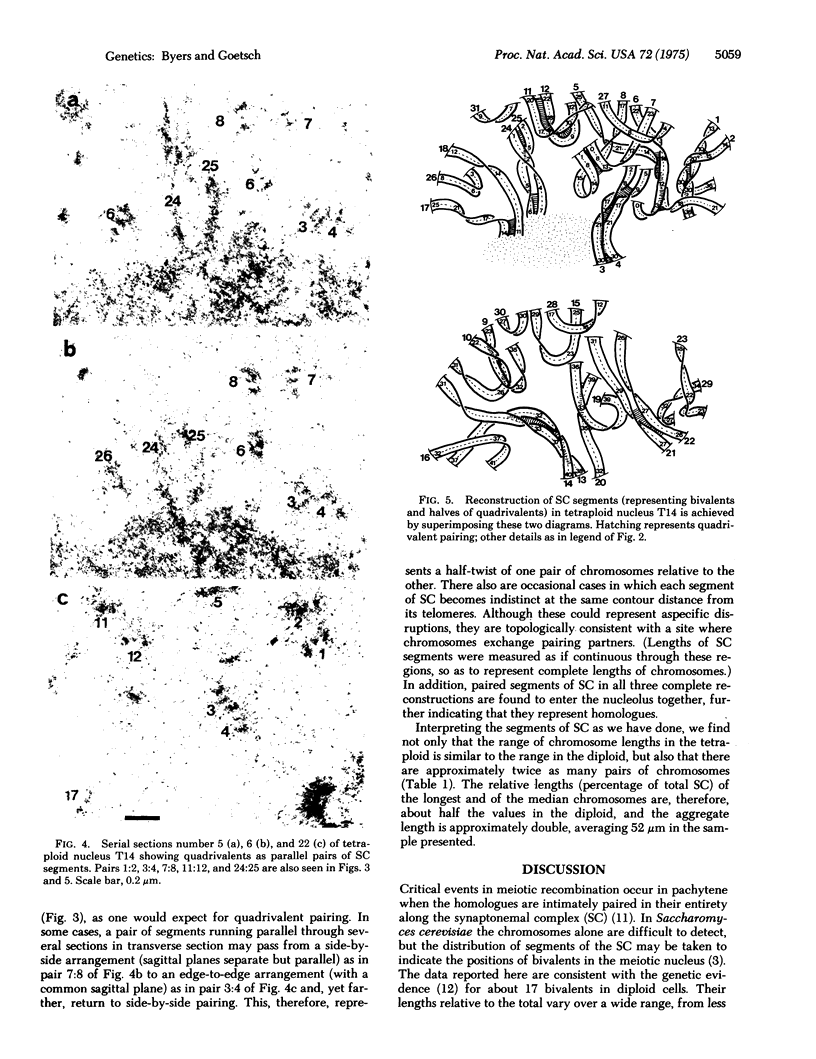Abstract
Certain strains of Saccharomyces cerevisiae contain visible segments of synaptonemal complex which are apparent components of bivalents in pachytene of meiotic prophase. The synaptonemal complex has the typical width in the frontal plane but is unusually thin in the sagittal plane, thus accounting for its poor visibility. Amorphous densities situated adjacent to the central element occur at intervals suggesting their coincidence with sites of crossing over. Reconstruction of the synaptonemal complex from serial sections has permitted karyotypic analysis. The number of segments of synaptonemal complex and the distribution of their legths is consistent with the genetic map. Two, possibly three, segments enter the nucleolus as if bearing sequences encoding ribosomal RNA. Reconstruction of tetraploid nuclei reveals an approximate doubling of the diploid chromosome number and confirms the pattern of nucleolar entry. Quadrivalent pairing is evident between the pairs of synaptonemal complex segments in the tetraploid nuclei.
Full text
PDF




Images in this article
Selected References
These references are in PubMed. This may not be the complete list of references from this article.
- Byers B., Goetsch L. Behavior of spindles and spindle plaques in the cell cycle and conjugation of Saccharomyces cerevisiae. J Bacteriol. 1975 Oct;124(1):511–523. doi: 10.1128/jb.124.1.511-523.1975. [DOI] [PMC free article] [PubMed] [Google Scholar]
- Carpenter A. T. Electron microscopy of meiosis in Drosophila melanogaster females: II. The recombination nodule--a recombination-associated structure at pachytene? Proc Natl Acad Sci U S A. 1975 Aug;72(8):3186–3189. doi: 10.1073/pnas.72.8.3186. [DOI] [PMC free article] [PubMed] [Google Scholar]
- Engels F. M., Croes A. F. The synaptinemal complex in yeast. Chromosoma. 1968;25(1):104–106. doi: 10.1007/BF00338237. [DOI] [PubMed] [Google Scholar]
- Finkelstein D. B., Blamire J., Marmur J. Location of ribosomal RNA cistrons in yeast. Nat New Biol. 1972 Dec 27;240(104):279–281. doi: 10.1038/newbio240279a0. [DOI] [PubMed] [Google Scholar]
- Gillies C. B. Reconstruction of the Neurospora crassa pachytene karyotype from serial sections of synaptonemal complexes. Chromosoma. 1972;36(2):119–130. doi: 10.1007/BF00285207. [DOI] [PubMed] [Google Scholar]
- Hartwell L. H., Mortimer R. K., Culotti J., Culotti M. Genetic Control of the Cell Division Cycle in Yeast: V. Genetic Analysis of cdc Mutants. Genetics. 1973 Jun;74(2):267–286. doi: 10.1093/genetics/74.2.267. [DOI] [PMC free article] [PubMed] [Google Scholar]
- Moens P. B., Rapport E. Synaptic structures in the nuclei of sporulating yeast, Saccharomyces cerevisiae (Hansen). J Cell Sci. 1971 Nov;9(3):665–677. doi: 10.1242/jcs.9.3.665. [DOI] [PubMed] [Google Scholar]
- Moens P. B. The fine structure of meiotic chromosome pairing in natural and artificial Lilium polyploids. J Cell Sci. 1970 Jul;7(1):55–63. doi: 10.1242/jcs.7.1.55. [DOI] [PubMed] [Google Scholar]
- Mortimer R. K., Hawthorne D. C. Genetic Mapping in Saccharomyces IV. Mapping of Temperature-Sensitive Genes and Use of Disomic Strains in Localizing Genes. Genetics. 1973 May;74(1):33–54. doi: 10.1093/genetics/74.1.33. [DOI] [PMC free article] [PubMed] [Google Scholar]
- Petes T. D., Byers B., Fangman W. L. Size and structure of yeast chromosomal DNA. Proc Natl Acad Sci U S A. 1973 Nov;70(11):3072–3076. doi: 10.1073/pnas.70.11.3072. [DOI] [PMC free article] [PubMed] [Google Scholar]
- Rasch E. M., Barr H. J., Rasch R. W. The DNA content of sperm of Drosophila melanogaster. Chromosoma. 1971;33(1):1–18. doi: 10.1007/BF00326379. [DOI] [PubMed] [Google Scholar]
- Roman H, Phillips M M, Sands S M. Studies of Polyploid Saccharomyces. I. Tetraploid Segregation. Genetics. 1955 Jul;40(4):546–561. doi: 10.1093/genetics/40.4.546. [DOI] [PMC free article] [PubMed] [Google Scholar]
- Simchen G. Are mitotic functions required in meiosis? Genetics. 1974 Apr;76(4):745–753. doi: 10.1093/genetics/76.4.745. [DOI] [PMC free article] [PubMed] [Google Scholar]
- Stern H., Hotta Y. Biochemical controls of meiosis. Annu Rev Genet. 1973;7:37–66. doi: 10.1146/annurev.ge.07.120173.000345. [DOI] [PubMed] [Google Scholar]
- Zickler D., Olson L. W. The synaptonemal complex and the spindle plaque during meiosis in yeast. Chromosoma. 1975;50(1):1–23. doi: 10.1007/BF00284959. [DOI] [PubMed] [Google Scholar]
- de Kloet S. R. Distribution of ribosomal ribonucleic acid cistrons among yeast chromosomes. J Bacteriol. 1973 Jun;114(3):1034–1039. doi: 10.1128/jb.114.3.1034-1039.1973. [DOI] [PMC free article] [PubMed] [Google Scholar]
- von Wettstein D. The synaptinemal complex and four-strand crossing over. Proc Natl Acad Sci U S A. 1971 Apr;68(4):851–855. doi: 10.1073/pnas.68.4.851. [DOI] [PMC free article] [PubMed] [Google Scholar]




